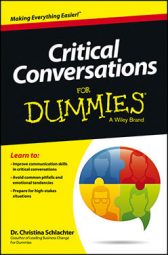Dismissing an employee is difficult, but critical conversation skills can make even that difficult process manageable. Through a critical conversation, you can find ways to fire an employee with compassion.
Critical conversations, even when followed up with action plans and evaluations, can't always turn the worst performers on a team into at least good employees. Sometimes an employee doesn’t have the ability or willingness to get the job done. If you take all appropriate steps to maintain an employee’s employment, with no success, it may be time to part ways and move on.
Don’t go it alone. Firing someone without working through an organization’s human resources department and within the constraints of company policy is like taking a big cruise ship through the northern Atlantic Ocean and forgetting to watch out for icebergs. After you work with your HR department, use these critical conversation skills to make sure everyone walks away from the employee termination in one piece.
Why should you care about letting an employee leave with respect? Employees talk. Employees post things on the Internet. Employees talk more. Letting an employee leave with respect makes the final interaction with the company as positive as possible considering the circumstances.
Critical conversation skill: Be professional and empathetic
Firing isn’t fun. Being fired isn’t fun. But you can fire someone with compassion. If all else fails and your human resources department supports the termination, stick to the facts and actions when going into the conversation.
Using the basics of the EDGE model, navigate your way through a firing critical conversation:
Examine the data: The performer has not completed the action plan or continues to not meet the expectations of the job.
Develop options: In this circumstance, developing options takes on a different meaning by informing how termination is the option that must be used.
Get moving: Detail the termination process, what steps will happen next.
Evaluate the impact: Find out how managers can learn from what led to the firing and perhaps how to spot potential performance issues earlier. Evaluation can also be personal reflection on how the critical conversation steps were used effectively.
Critical conversation firing examples
Here are two examples of fact–action messages that help people leave with respect:
Fact: “John, four weeks ago we developed an action plan to improve your performance on the team. In every meeting we’ve had, we’ve discussed that none of the actions have been complete.”
Action: “We’ve worked together to try to support you in achieving your goals, but because they haven’t been met, I’m going to be terminating your employment. I’d like to use this meeting to walk you through the termination process.”
Fact: “Janice, your sales performance hasn’t met the expectations of our plan or of the team. After six weeks, your sales numbers continue to fall.”
Action: “Based on these facts, it’s time to terminate your employment. I want to assure you that I’ll do everything I can to support you through this time and transition. I’d like to walk you through the process now.”
Although the termination may seem like just the final straw in a long series of conversations, it deserves as much attention and planning as all the previous conversations.
Try to resist the urge to apologize profusely or soften the message too much when you’re firing someone. Saying “I’m sorry I have to let you go, I really don’t want to do this,” puts all the responsibility on you, rather than simply stating the fact that this is the action that’s being taken because an employee’s performance wasn’t up to par (even after many attempts to help).
Up to the point of firing an employee, a manager should take the time to create collaborative plans that inspire performance. When the decision is made to fire someone because of continued poor performance, the action shouldn’t be a surprise. Simply state the facts and action clearly, and then move on to what’s happening next.

